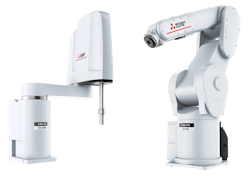Robots Are a Key Tool for Data Acquisition
Data has become a central element in the ongoing drive to push production quality and efficiency higher. And one area where this collection can occur is with robots. Yet all too often, factory managers fail to see robots' potential to glean useful information while helping to automate operations.
Why Focus on Robots?
Robots are seeing increased use as the benefits of automation rise. Declining costs, improved performance and simpler programming make robots more attractive. When manufacturing teams deploy these machines, it’s fairly straightforward to enhance data collection and add test-and-inspection stations.
The most basic data collection comes from the robot itself. It can monitor parts production and inventory consumption, telling systems how many elements were used in any given time period. This information also comes with time stamps, so it’s simple to store information regarding when each component was handled. Such ability is particularly important in regulated environments, where easy access to historical data on hand-offs can be an important factor when products must be recalled.
The ancillary equipment used with robots can also bring a wealth of data. Visual sensors, grippers and other gear all have the potential to provide some additional data.
A Structure for Data Collection Success
It’s often fairly simple to add inspection stations to robotic work cells. Cameras used to guide robotic movement can also be used to examine components. The presence of key component features as well as measurements are some of the more common types of checks. These visual inspections can often be made while parts are being moved or manipulated in order to maintain high operating speeds.
In addition, sensors can easily be added to check other parameters. When these inspection stations are installed in work cells, quality checks can be increased with minimal impact on throughput. Additional monitoring can bring major improvements. It’s easier to spot trends when more parts are checked, so changes can be made before defective parts are made.
These quality checks can also help resolve problems with customers. For example, a company that has proof that parts met requirements when they left the facility can easily resolve a dispute where the shipper may have damaged goods.
These improvements come from analyzing data points in real time. But big benefits come when large amounts of collected information are mined. Data mining lets operators and maintenance technicians look at many different parameters over long periods.
When recurring problems with production equipment arise, archival data can be examined so analysts can understand what happened before a fault occurred. This information can be used to prevent future breakdowns. When the parameters that precede faults are spotted, maintenance can be performed before a failure causes an unplanned shutdown, improving overall plant efficiency.
Trends in Managing This Data
At present, much of this analysis will be based on the knowledge of engineers, technicians and even equipment providers. But in the near future, it’s likely that deep learning systems will analyze the huge volumes of data collected. Some form of artificial intelligence may be needed when enterprises want to analyze equipment that’s used in plants at many different global facilities. Turning the data from many high-performance machines into useful data may be beyond the analytical scope of most humans. However, it may be a while before conservative manufacturing companies rely on machine learning systems.
While that’s a long-term issue, the question of where to store all this data is an important decision today. Often, a storage hierarchy can be an effective solution. Basic data can be stored in the robot’s controller. When that limited capacity is surpassed, older data can be moved to the company’s manufacturing execution system (MES). There, large volumes of data can be stored for corporate review. When local storage capacities are exceeded, companies generally turn to the cloud. These data centers will store as much data as the company wants to pay for. Cloud services are especially important for enterprises that want to store data from several facilities.
While it might seem that adding robots and inspection stations is a big investment, many observers explain that the benefits of installing more quality inspections often outweigh the costs. If a supplier sends defective parts to a major customer, then that customer may demand 100% inspection on those products until quality levels return to normal. The cost of a few cameras and sensors is well below the expenses associated with a recall effort and hurriedly adding inspection practices in response to a customer problem.
Companies that have installed robots may be surprised to find out how effective it can be to add sensors and perform more inspections. Those who haven’t yet deployed these automatons are often pleased to learn that there can be substantial benefits with robotic systems beyond the automation speed and accuracy that are the main attractions for many installations. When robots are integrated into manufacturing processes along with the applicable sensors, users have the opportunity to collect a lot more data, bringing significant improvements to their manufacturing operations.

